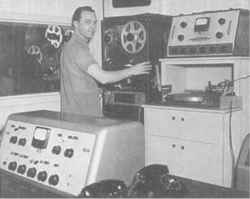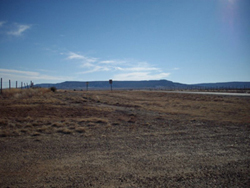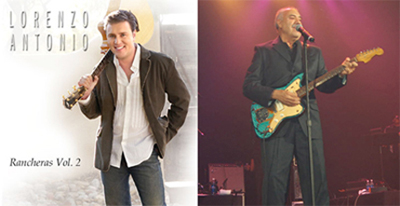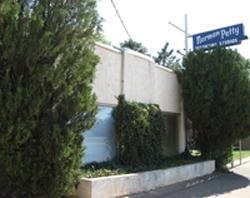Two Very Historical LA-2A’s
In early 2009 an interesting LA-2A arrived from New Mexico for servicing. When we began work on this unit and saw it up close, we realized that it was a very unusual piece. What made it so special? Well, it was an early, entirely original unit, but in mint, stunning condition. It looked like it had just come off the assembly line – truly, not even a speck of dust was visible inside. The interior and components showed no age, discoloration, or signs of heat. All the metalwork and hardware was shiny and squeaky clean. We’ve seen a few counterfeits, and briefly wondered if this one might be fake, but there was no way — the parts, silk screening, and metal work were just too perfect. How could a 40 year old LA-2A be in such amazing condition?

Norm Petty in the original studio
When I phoned our client to discuss the repair, he told me about the unit’s surprising history. It turned out that this was one of two units originally owned by the legendary Norman Petty. Mr. Petty produced and engineered nearly all of the hit records for Buddy Holly, and had recorded many other acts like The Fireballs (“Bottle Of Wine”) and Jimmy Gilmer (“Sugar Shack”). Mr. Petty also worked on early recordings with Roy Orbison, Buddy Knox, Waylon Jennings, and Carolyn Hester. All these classic rock tracks were recorded at his studio in the little town of Clovis, New Mexico – just 10 miles from the Texas border. Those LA-2A’s must have been used on lots of amazing sessions!

Clovis, New Mexico Scenery
In addition to his many rock hits, Mr. Petty also recorded a string of Latin hits with “Tiny Morrie” Sanchez, a soulful cancione performer with a large and dedicated following.
In the late 1960’s Norm Petty moved his studio to a new location (in an older theater). Tiny Morrie was now running Hurricane Records in Albuquerque, with a studio built by him and Norm. The LA-2A’s traveled across the state to Morrie’s Hurricane Studios. But in 1982 Hurricane closed, and the LA-2A’s were packed and put into storage. In 1989 Morrie sent the RCA tube console back to the museum in Clovis, but the LA-2A’s stayed packed away. A few years later Morrie and his son Lorenzo were setting up a new studio and they fired up the LA-2A’s, but one unit had problems. The owners decided to put them back into storage for a while – another 17 years, as it turned out.
In 2009, 27 years after the two LA-2A’s had been put into storage, Morrie and Lorenzo decided that it was time to have them serviced. Lorenzo explained in an email “You were highly recommended by Bayard Banner from Grandmas Music and Sound here in Albuquerque. We decided to take a chance by sending you the unit and I’m very glad that we found you.”

Lorenzo Antonio and his father – Tiny Morrie
It turns out that Lorenzo Antonio is also a well known and prolific Latin Music star, with a huge discography. There are 30 CD’s listed on his site. Lorenzo also operates a scholarship foundation for New Mexico high school students.
The unit was serial number 1239, a Revision 2 LA-2A. The “add on” adhesive badge on the rear showed that it was built in North Hollywood by Studio Electronics. (This short lived brand, owned by Bill Putnam and not related to our company, would soon be renamed UREI.) The rear panel sported mint, original HA-100X input and A-24 output transformers (by UTC), and an original T4A opto attenuator.
After the initial recap and refurb were completed, we found that despite #1239’s pristine appearance, it had numerous problems and was a somewhat difficult repair. The original T4A opto attenuator was shot, and the 12AX7 input stage tube was noisy. After installing a new old stock UREI T4B and a new input tube, the real fun began! Challenge #1 was instability in the 65 volt supply rail, which powers the GR metering circuit. A neon lamp wired as a zener reference loosely regulates this circuit but in this case the new lamp intermittently flickered , a sign that something, somewhere, wasn’t right. Visual inspection revealed a small pinhole in the “fish paper” insulator between the turret board and the chassis. This is an unusual, but not unheard of issue – over time, high voltage potential between a high voltage turret terminal and the chassis had burned a tiny hole through the insulator. Perhaps moisture or trace amounts of contamination had caused this. A small fish paper “patch” quickly fixed the problem.
The unit sounded great, and worked beautifully – but just for an hour or so, and then, inexplicably, there was no compression. It passed audio just fine, but would not limit. What had happened? Initial checks showed no excitation voltage on the T4B, and no output on the 6AQ5 driver tube. I then noticed that the tube was cold – for a “fire bottle”, certainly an unhealthy condition! In keeping with Murphy’s Law, replacing the tube made no difference. Then after a few minutes the tube suddenly lit up, and all was fine again. The weird intermittent problem turned out to be a break inside one of the twisted heater wires. Tess opened up the wire harness, replaced the 6AQ5 heater pair (with same gauge and color, of course), and the issue was resolved.

The museum (open by appointment)
But the unit had one more trick in store. After running for another hour or so, a very low level intermittent popping noise appeared. It was way down there, nearly buried within the normal background hiss, but something was clearly wrong. With most analog gear, low level noise problems usually occur at the front end, where all the gain takes place, so that was certainly the place to look. The preamp tube had already been replaced but in these sensitive circuits, nearly any component can cause noise problems – a capacitor ,resistor, tube socket, even an incorrectly positioned piece of wire. In this case the problem was a noisy 68k carbon resistor in the feedback loop. We installed an exact replacement and the unit worked perfectly, finally back to it’s original specs. As I write this we are starting refurb on Antonio and Morrie’s other LA-2A. Maybe that one will be a little easier to repair.
We were very proud to have had the chance to work on such a unique piece of recording equipment. Norm Petty passed away in 1984 but amazingly the original studio is still there, in Clovis, New Mexico. It operates as a museum, with tours available by appointment. My wife and I often travel through the Southwest, and I hope to visit the place some day.
David Kulka
March 2009

